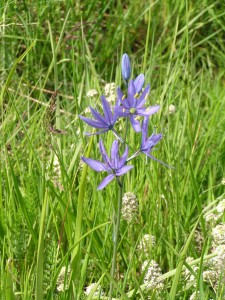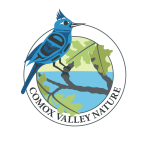For a naturalist these current times can be depressing with widespread ecological destruction being one of the constant themes of life in the new millennium. However optimism is also part of the human condition and with most naturalists it gains momentum every spring with perhaps the arrival of the first rufus hummingbird or the first salmonberry bloom.
For myself this moment happened in June during a walk through the Courtenay Air Park when I noticed several camas plants in bloom. The camas is a special plant intertwined with the history of our region. The American explorer Meriwether Lewis of Lewis and Clark fame described the beauty of fields of camas so vast that they appeared as small lakes of clear water. Many early European explorers did not believe that a lansdcape so beautiful could be possible without man caring for it. In fact they were right. The camas fields were not wild. Many First Nations tended these fields. The camas produces a bulb which when steamed is a nutritious source of carbohydrate. The camas bulbs were thus highly prized. They could be stored, used for making flour, and frequently traded amongst First Nations. Camas fields were highly valued, and were tended by their first owners though not in the traditional methods to which Europeans were accustomed.
There are two camas species found locally, the common camas and the great camas. Besides the size difference the flowers have slightly different diagnostics. The colour of the bloom varies from a pale lilac to a deep magenta. Occasionally a pure white bloom can be found.
The camas is often associated with the Garry Oak ecosystem where it frequently grows. Unfortunately on Vancouver Island only remnants of this most beautiful of ecosystems remain. In the Courtenay Air Park the Comox Valley Naturalists have been working for many years to create a small piece of Garry Oak ecosystem. Non-native invasive plants such as Scotch Broom and Himalayan black berry have been systematically removed, while native plants such as Garry Oak have been planted and tended.
Over five years ago a large quantity of camas seed was scattered and covered with mulch. I for one had given up on ever seeing the camas emerge. Last year I found a couple of flowering plants which I dismissed as a fluke. This year there was no mistaking that a small patch had indeed taken hold. When it is not flowering, the camas plant is a rather nondescript lily-type plant. However in flower there is no mistaking this native blue jewel. Recent DNA testing has resulted in camas being removed from the lily family.
I look forward to the day in the future when the Courtenay Air Park is blue with the blooms of camas under the pale green of Garry Oak trees. The Naturalists’ vision for this Park is part of their Wetland Restoration Project which fights invasive plants in the Courtenay River Estuary. Recently we have erected a new sign on the viewing platform overlooking the lagoon explaining our work in the area.
This work is made possible though funding this year received from the City of Courtenay, the Comox Valley Regional District, BC Nature, and Ducks Unlimited Canada for which we are grateful.



I enjoyed this article. Would you please tell me where the Courtenay Air Park is – I’d like to drive up from Parksville and see the wild camas. They should be coming out in bloom right about now, don’t you think?